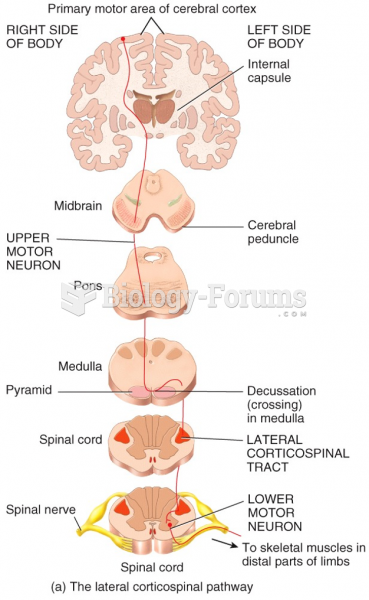Answer to Question 1
a
Answer to Question 2
Do brains also differ as a function of sexual orientation? The results are complex. On average, homosexual men are shifted partly in the female-typical direction for some brain structures but not others. Similarly, on average, homosexual women's brains are slightly shifted in the male direction in some ways but not others. Several of the reported differences have no clear relationship to sexuality itself, although they may relate to other behavioral differences between heterosexual and homosexual people.
On average, the left and right hemispheres of the cerebral cortex are of nearly equal size in heterosexual females, whereas the right hemisphere is a few percent larger in heterosexual males. Homosexual males resemble heterosexual females in this regard, and homosexual females are intermediate between heterosexual females and males. Also, in heterosexual females, the left amygdala has more widespread connections than the right amygdala, whereas in heterosexual males, the right amygdala has more widespread connections. Again, homo- sexual males resemble heterosexual females in this regard, and homosexual females are intermediate. The anterior commissure is, on average, larger in heterosexual women than in heterosexual men. In homosexual men, it is at least as large as in women, perhaps even slightly larger. The suprachiasmatic nucleus (SCN) is also larger in homosexual men than in heterosexual. However, when interpreting these and other reported differences, we should remember two cautions: First, we don't know whether these brain differences are causes or effects of sexual orientation. Brain differences can predispose to different behaviors, but it is also true that persistent behaviors can change brain anatomy. Second, it is relatively easy to publish results showing a difference between two groups, such as homosexual and hetero- sexual people, even if the difference was unpredicted, small, and hard to explain. It is less easy to publish results showing no difference. Thus it is possible, even likely, that the published papers overstate certain anatomical differences.
The most widely cited research concerns the third interstitial nucleus of the anterior hypothalamus (INAH-3), which is generally more than twice as large in heterosexual men as in women. This area has more cells with androgen receptors in men than in women, and probably plays a role in sexual behavior, although the exact role is uncertain and probably varies among animal species. Simon LeVay examined INAH-3 in 41 people who had died between the ages of 26 and 59 . Of these, 16 were heterosexual men, 6 were heterosexual women, and 19 were homosexual men. All of the homosexual men, 6 of the 16 heterosexual men, and 1 of the 6 women had died of AIDS. LeVay found that the mean volume of INAH-3 was larger in heterosexual men than in heterosexual women or homosexual men, who were about equal in this regard. The difference between heterosexual men and the other two groups is fairly large, on average, and that the cause of death (AIDS versus other) has no clear relationship to the results.
A later study partly replicated these trends. Researchers found that the INAH-3 nucleus was slightly larger in heterosexual than homosexual men, although in this study the homosexual men's INAH-3 nucleus was larger than that of heterosexual women. Still another study found INAH-3 to be larger in heterosexual males than in male-to-female transsexualsthat is, people born as males who changed their identities to female.
The meaning of these results is not clear. Do differences in the hypothalamus influence sexual orientation, or does sexual activity influence the size of hypothalamic neurons? Some brain areas do grow or shrink in adults because of hormones or behavioral activities. About 8 percent of rams (male sheep) direct their sexual behavior toward other males. One area of the anterior hypothalamus is larger in female-oriented rams than in male-oriented rams and larger in male-oriented rams than in females. This area becomes larger in male than female sheep before birth as a result of prenatal testosterone levels. In sheep, at least, an anatomical difference appears before any sexual behavior, and so it is more likely a cause than a result. The same may or may not be true in humans.







